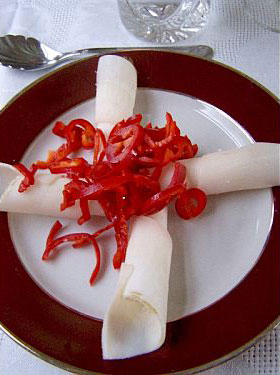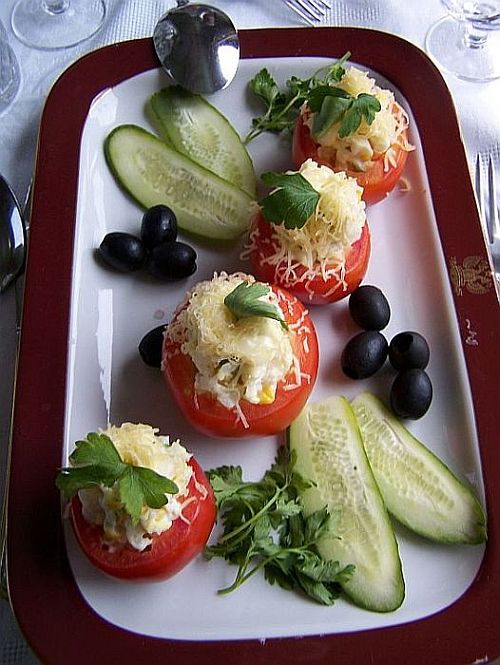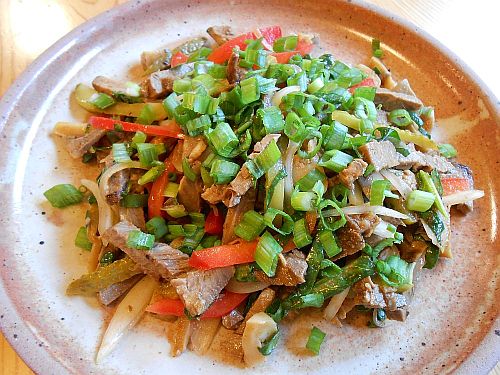1900 Park Fare Mongolian Beef Recipe
Story and Photos by Sharon Hudgins
If you've ever eaten on the dining car of a train, you know that dinner on the diner can range from dismal to delightful. But who would ever think of taking a Trans-Siberian train nearly 6,000 miles across Russia for the culinary experience?
 |
| Local food vendors, circa 1900. |
Think again. Back around 1900, when the new Trans-Siberian Railroad began long-distance passenger service, a few of the first-class dining cars and station buffets were sumptuous indeed, serving gourmet dishes, fine wines, and French brandies to well-heeled customers. But in the Soviet period, during much of the 20th century, eating on the trains was a proletarian experience at best. Food in the sparsely stocked dining cars was often worse than at a factory workers' canteen, served on soiled tablecloths by surly waiters. So savvy rail riders carried their own provisions on the train or bought home-cooked snacks from local vendors on the station platforms along the way. That was still the case in the mid-1990s, when I worked in Russia and the Trans-Siberian was my "commuter train" there.
 |
| The sumptuous Dining car on the Golden Eagle Trans-Siberian Express train. |
Fast-forward to 2007, when I was a lecturer for National Geographic Expeditions on a "land cruise" that crossed Russia and Mongolia on a new, $25 million private train operated by a British company, Golden Eagle Luxury Trains. Multi-course meals in the two ornate dining cars were prepared by well-trained Russian chefs who cooked everything from scratch, including baking fresh breads and pastries overnight while the passengers slept in their cozy cabins, rocked to sleep by the rhythm of the rails. Except at breakfast, no dish was ever served twice on the 12-day trip, and the good wines poured freely at every lunch and dinner made the journey across two continents—Europe and Asia—seem even more leisurely.
Since then I've crossed Russia several more times by train. And when I added up all those trips, I realized that I've ridden nearly 40,000 miles on the Trans-Siberian tracks, spent a total of three months on Russian trains (from gritty "hard class" to glitzy luxury class), and eaten 270 meals on (or near) the railway diners.
That's why I was recently invited to create a Trans-Siberian Railway dinner for the Buckland Club in Birmingham, England, a venerable gastronomic society established in 1952. Twice a year it hosts formal dinners that honor the spirit, and the tastes, of Francis Trevelyan Buckland, a rather eccentric 19th-century English surgeon, scientist, writer, and lecturer, who had a reputation for eating anything no matter how bizarre or culturally unacceptable. A kindly lover of animals, Buckland kept many domestic and exotic pets at home—and had no qualms about consuming their flesh after they passed away from old age. He also chowed down on hedgehogs, mice, rats, owls, moles, buzzards, panthers, ostriches, and other local and foreign fauna. Today's members of the Buckland Club also expect to have their palates challenged.
As a longtime chilehead, I couldn't resist including some tongue-tingling foods on the menu I created for that Trans-Siberian dinner: 6 courses, 15 dishes, and plenty of matching vodka, wines, and brandy to wash them all down. Most outsiders think that Russians don't eat any hot-spicy foods at all. But Russians love their hair-raising horseradish and sinus-clearing mustard (comparable to Colman's), as well as fresh garlic that packs its own punch. On the Asian side of Russia, the foods of nearby China, Korea, and Central Asia have long influenced the taste buds of people living in the southern part of Siberia. Out in the Russian Far East, my friends enjoy squirting Thai and Vietnamese chile sauces on their Siberian pel'meni (dumplings stuffed with meat, fish, mushrooms, etc.) and sprinkling their fresh local seafood with soy sauce mixed with crushed hot red pepper flakes.
For the 85 guests at the Buckland Club dinner, I composed a menu that included dishes from the dining car of the Golden Eagle Trans-Siberian Express, as well as traditional foods from many of the regions the railroad crosses between Moscow, in European Russia, and Vladivostok, on the Asian side where Russia meets the Pacific Ocean. The Buckland pre-dinner reception featured canapés of buttered bread topped with red and black caviars, followed by stroganina, aka "Siberian frozen sashimi," paper-thin shavings of frozen raw fish dipped in the diners' choice of ground hot red pepper, black pepper, salt, or finely chopped fresh garlic. Tongues were cooled with shots of ice-cold Russian vodka and flutes of dry champagne from the former Soviet state of Georgia.
Typical of a festive Russian meal, we started with an array of several different cold zakuski (appetizers), all served
 | |
| Siberian pel'meni, meat-stuffed dumplings, considered "the national dish of Siberia" |
on the table at the same time, followed by wild mushroom soup with sauerkraut-stuffed pastries on the side. The cold dishes included tomatoes stuffed with pungent garlic cheese, spicy Korean carrot salad from the Russian Far East, and spicy Mongolian beef salad representing a branch line of the railroad that runs through Mongolia. The main course consisted of classic Siberian pel'meni dumplings, with two separate stuffings: "Forest dumplings" with venison and blueberries, garnished with butter and sour cream; and "Far Eastern dumplings" filled with salmon, green onions, and fresh ginger (a bit of kick there), with soy sauce or black vinegar to sprinkle on top.
Dessert was Siberian frozen cranberry cream garnished with pine nuts and wild berries, accompanied by sweet red and white wines from the Massandra Winery in the Crimea, established by Tsar Nicholas II in the 1890s, around the same time the new Trans-Siberian tracks were being laid across Russia. And for those guests who still had room for more, the waiters served cups of strong black tea, flavored with fresh lemon and fruit preserves, along with sticky-sweet Central Asian honey-almond confections and small glasses of Georgian brandy.
 |
| Ukrainian salo, cured pork fat with hot red peppers |
In retrospect, there was one more spicy dish I should have included on that Buckland Club menu. On several of my trips across Russia on the Golden Eagle train, the dining car chefs cooked a special Ukrainian meal that began with an appetizer of salo, thin slices of cured raw pork fat garnished with fresh, very hot, red or green peppers and accompanied by shots of fiery Pertsovka, pepper-spiked vodka that tastes like high-octane serrano juice. Good old Frank Buckland would have loved it. But would there have been room on the table (or in the stomachs) for yet another dish at that dinner held in his honor? After a meal lasting for five hours, those Buckland Club gastronomes were ready to retire to their beds, lulled to sleep by visions of frosty feasts in Siberian forests, and dreaming of the next stop on a Trans-Siberian train.
Priiatnogo appetita! (That's Russian for "Enjoy your meal!")
BUCKLAND CLUB MENU – BIRMINGHAM, ENGLAND – 14 MARCH 2013
Welcome Reception
Stroganina (Siberian Frozen Sashimi)
Caviar Canapés
Apéritif: Russian Vodka, Georgian "Bagrationi 1882 Classic" Brut Champagne
First-Course Zakuski (Appetizers)
Variety of Open-Face Sandwiches
Fresh Tomatoes Stuffed with Garlic Cheese
Beet Salad with Walnuts & Prunes
Spicy Korean Carrot Salad
Golden Eagle Chicken Salad with Cucumber, Walnuts, & Peas
Mongolian Spicy Beef Salad
Vladivostok Potato Salad with Crabmeat & Salmon Caviar
Wines: Hungarian Dry "Furmint" 2010 White Wine
Bulgarian Vinica Zagreus, Mavrud Reserve 2006 Red Wine
Soup Course
Cream of Wild Mushroom Soup
Small Pastries filled with Sauerkraut
Main Course
Siberian "Forest" Dumplings filled with Venison & Blueberries
"Russian Far East" Dumplings filled with Salmon, Green Onion, & Fresh Ginger
Condiments: Butter, Sour Cream, Soy Sauce, Black Vinegar, Green Onion Tops, Fresh Parsley
Dessert
Siberian Frozen Cranberry Cream with Wild Berries & Pine Nuts
Central Asian Honey-Almond Bars
Black Tea with Fresh Lemon & Fruit/Berry Preserves
Georgian Sarajishvili 3-Star Brandy
RECIPES (4)
STROGANINA (aka "Siberian frozen sashimi")
Stroganina is an ancient native Siberian food—just frozen raw fish, usually a firm, white-fleshed, Arctic river fish—sliced into paper-thin pieces that melt on your tongue. (One 19th-century American traveler in Russia's North described stroganina as looking like pinewood shavings but tasting better.) This dish is still popular in Siberia, where locals even host stroganina festivals in the winter.
Use the freshest, best-quality, firm-fleshed fish you can find, freeze it well, then let it thaw just a bit so you can slice it very thin with the sharpest knife in your kitchen. Serve immediately on a chilled plate, with separate small bowls of salt, black pepper, ground hot red pepper, and finely chopped garlic to dip the pieces into. The only proper drink with stroganina is icy-cold Russian vodka.
The use of black pepper as a garnish probably dates from sometime after the 13th century, after the Mongols introduced black pepper to Russia from China. Ground red pepper as a garnish is popular in Siberia today, too; after capsicum peppers were discovered by Europeans exploring Central and South America in the 15th and 16th centuries, they were later brought to this part of Russia by the Chinese and Koreans.
RUSSIAN GARLIC CHEESE
Called pikantny syr (spicy cheese) in Russian, this is a popular appetizer in Siberia and the Russian Far East. Restaurants often serve it as a stuffing for ripe red tomatoes, or as a spread for chewy-textured Russian rye bread. Plenty of garlic provides the kick; you can also add some cayenne pepper or hot paprika to make the cheese even spicier. Russians make this dish by putting the cheeses through a meat grinder—but you can shred the cheese with a grater or even in a food processor.
1/2 pound medium-sharp white cheddar cheese, finely shredded
1/2 pound Emmentaler cheese, finely shredded
1/4 cup full-fat sour cream (containing no additives)
1/4 cup full-fat mayonnaise
8 to 10 large garlic cloves, put through a garlic press
1/2 teaspoon ground cayenne pepper or hot paprika (optional)
1/4 teaspoon salt
Toss the shredded cheeses by hand in a large bowl. Mix the sour cream, mayonnaise, garlic, hot pepper (optional), and salt together in a small bowl, then add to the cheese, stirring to mix well. Cover and refrigerate at least 4 hours (and preferably overnight) to let the flavors meld. Let the cheese mixture come to room temperature before serving. Use as a stuffing for small firm ripe tomatoes or cherry tomatoes, as a topping for baked potatoes, or as a spread for dark bread.
Makes approximately 3 cups.
SPICY KOREAN CARROT SALAD
This popular appetizer from Russia's Maritime Territory on the southern Pacific coast shows the Korean influence on the cuisine of that region. Recipes for this spicy salad migrated to Uzbekistan and Kazakhstan with the Koreans living in the Russian Far East who were deported by Stalin to Central Asia in the 1930s. The dish subsequently spread to many parts of Russia as well—and eventually to the United States, where you can find it on the menus of Russian and Uzbek restaurants in New York City, and in other parts of the country, such as Texas, where it's sold in Russian delicatessens. There are several variations of this recipe—some more hot-spicy than others—using black pepper, ground coriander seeds, bay leaves, parsley, vinegar, and sugar, as well as foraged foods such as wild onions and wild garlic. You can now even buy ready-made spice mixes for "Korean-Style Carrots" in Russia.
NOTE: Sunflower oil, preferably not too refined, is essential for the authentic taste of this salad.
1 pound (16 ounces) carrots, peeled and grated lengthwise into long thin strips
1-1/2 teaspoons ground cayenne pepper
1/2 teaspoon salt
3 tablespoons sunflower oil
2 large garlic cloves, put through a garlic press
1 green onion (white and tender green parts), finely chopped
Put the grated carrots into a medium-size heatproof bowl. Make a well in the center of the carrots, pushing them aside so you can see the bottom of the bowl. Put the cayenne pepper and salt into this well. Heat the oil in a small skillet until it is very hot. Pour the hot oil over the spices in the bowl, stirring rapidly to mix them into the oil, then stir the garlic into the oil. Stir the seasoned oil into the grated carrots until all the ingredients are well combined. Add the chopped green onion and toss the ingredients to mix them together well.
Cover and refrigerate until needed. This salad tastes best if you make it a day in advance, for the flavors to develop fully. Let the chilled carrot salad sit at room temperature for 30 minutes before serving.
Makes 4 to 6 small servings.
 MONGOLIAN SPICY BEEF SALAD
MONGOLIAN SPICY BEEF SALAD
I ate this spicy salad on a day trip off the Golden Eagle train, at a camp in the Gorkhi-Terelj National Park outside of Ulaanbaatar, the capital of Mongolia. The recipe shows the influence of northern Chinese and Russian ingredients (pickled vegetables) on traditional Mongolian cuisine (which emphasizes meat and milk dishes, not vegetables).
2-1/2 to 3 pounds boneless chuck roast (choice grade), roasted until well done, then cooled*
1 cup bottled pickled mushrooms (12-ounce net weight bottle), rinsed, drained, and dried
1 large sour dill pickle
1/2 large onion
1/2 large fresh red bell pepper
10 to 12 large fresh spinach leaves, washed and dried
1/4 cup sunflower oil
1/4 cup white vinegar
1-1/2 to 2 teaspoons ground cayenne pepper
1 teaspoon salt
Garnish: 1/2 cup fresh green onion tops, thinly sliced crosswise into rounds (measured after slicing)
*Or any other cut of boneless beef suitable for roasting
Trim the fat and any heavily charred areas off the roasted beef. Cut the beef across the grain into thin pieces, then slice the pieces across the grain into thin strips (about 3 to 4 cups total of beef strips). Julienne (slice into matchstick-size pieces) the mushrooms, dill pickle, onion, bell pepper, and spinach leaves. Put all of these into a large bowl with the beef strips and toss to mix well.
In another bowl, whisk together the sunflower oil and vinegar until the mixture becomes cloudy and a bit thick. Whisk in the cayenne pepper and salt. Pour over the beef and vegetables, tossing them together until all the pieces are well coated with this dressing. Cover and refrigerate for several hours, to let the flavors meld.
Before serving, let the salad sit at room temperature for about 15 minutes, then toss the ingredients together once more. Garnish each serving generously with sliced green onion tops.
Makes approximately 6 cups (6 to 8 to 12 side servings).
———————————————
Sharon Hudgins is the author of The Other Side of Russia: A Slice of Life in Siberia and the Russian Far East (Texas A & M University Press, 2003, available at www.amazon.com ). For more of her travel stories and recipes, see her own website at http://www.sharonhudgins.com
For information on Trans-Siberian Railroad tours, see Golden Eagle Luxury Trains, http://www.gwtravel.com , and National Geographic Expeditions, www.nationalgeographicexpeditions.com
Source: https://www.fieryfoodscentral.com/2013/04/04/dinner-on-the-diner-trans-siberian-style/
0 Response to "1900 Park Fare Mongolian Beef Recipe"
Post a Comment